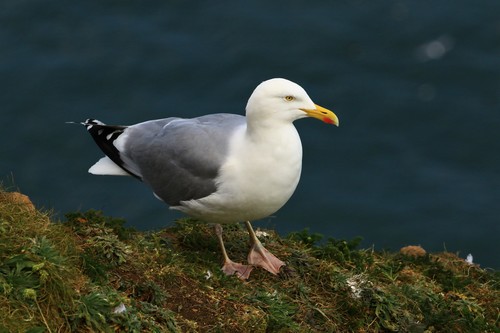
Herring Gull
The Herring Gull (*Larus argentatus*) is a large, widespread gull species found across the Northern Hemisphere. Known for their adaptability, these birds are common sights in coastal areas, landfills, and even inland habitats. They play a significant ecological role as scavengers and predators, helping to control populations of smaller animals and clean up organic waste. While often viewed as commonplace, Herring Gulls have complex social behaviors and display remarkable intelligence. They do not have specific cultural import, but are very recognizable.
55-67 cm
Length
137-152 cm
Wingspan
Least Concern
Conservation Status
Distribution
Northern Hemisphere, including North America, Europe, and Asia. Migratory, with northern populations moving south for the winter. Found along coastlines, but also inland near lakes, rivers, and human-altered habitats.
Lifespan
Up to 30 years in the wild, though average lifespan is likely shorter.
Herring Gull's Habitat
Habitat Types
Coastal areas, Estuaries, Lakes, Rivers, Landfills, Agricultural fields
Climate Zones
Temperate, Subarctic, Arctic
Adaptations
Herring Gulls are highly adaptable to various food sources and habitats. Their strong beaks and digestive systems allow them to consume a wide range of food items. They can also tolerate a wide range of temperatures.
Variations
Several subspecies are recognized, differing slightly in size and mantle (back) coloration. For example, the European Herring Gull (*L. a. argenteus*) tends to have a lighter gray mantle than the American Herring Gull (*L. a. smithsonianus*).
Appearance
Breeding Plumage
Adult breeding plumage features a white head, body, and tail, with a light gray back and wings. Non-breeding adults have some brown streaking on the head and neck.
Seasonal Feather Changes
Plumage changes are primarily related to age. Juveniles are mottled brown, gradually acquiring adult plumage over 3-4 years.
Sex Based Plumage Differences
Limited sexual dimorphism in plumage; males and females are very similar.
Notable Features
Yellow bill with a red spot on the lower mandible, Pink legs, Dark eyes in juveniles, yellow eyes in adults, Stout build
Diet and Feeding
Primary Foods
Fish, Invertebrates, Carrion, Refuse, Eggs, Small birds, Rodents
Foraging Behavior
Herring Gulls are opportunistic feeders, employing various foraging techniques. They may scavenge on beaches, steal food from other birds (kleptoparasitism), drop shellfish onto hard surfaces to break them open, or follow fishing boats.
Specializations
Their generalized diet and strong beaks allow them to exploit a wide range of food resources.
Seasonal Diet Variations
Diet can vary seasonally based on food availability. For instance, they may consume more fish during the breeding season when feeding chicks, and more refuse during the winter.
Behavior
Social Structure
Highly social, often found in large flocks, especially outside the breeding season. They form breeding colonies that can range from a few pairs to thousands of birds.
Communication
Vocalizations (a wide range of calls, including the familiar 'laughing' call), Body postures (e.g., head-tossing, bowing), Visual displays
Migration
Many populations are migratory, moving south in the fall and returning north to breed in the spring. Migration distances vary; some populations are resident year-round.
Territorial or Group Behaviors
Herring Gulls are territorial during the breeding season, defending their nesting site from intruders. Outside the breeding season, they often form large communal roosts.
Conservation
Threats
Habitat loss (coastal development), Pollution (including plastic ingestion), Climate change (affecting prey availability), Human disturbance
Protection Programs
Some populations are protected under national and international laws (e.g., Migratory Bird Treaty Act in the US)., Habitat restoration projects
Local National Laws
Varies by country and region. Generally protected, but may be subject to control measures in some areas due to conflicts with humans.
Population Trend
Stable
Population Estimates
Global population estimated to be in the millions.
Interesting Facts
Herring Gulls can drink both fresh and saltwater.
They have specialized glands above their eyes that excrete excess salt.
They are known for their intelligence and problem-solving abilities.
They have been observed using tools (e.g., dropping shells onto rocks) and learning complex foraging techniques.
Herring Gulls can sometimes hybridize with other gull species.
This can make identification challenging in areas where ranges overlap.
Faqs about Herring Gull
Are Herring Gulls aggressive?
They can be aggressive, especially when defending their nests or young, or when competing for food. It's best to give them space.
What is the lifespan of a Herring Gull?
They can live for up to 30 years in the wild, although the average lifespan is often shorter.
Why do Herring Gulls gather at landfills?
Landfills provide an easy and abundant source of food for these opportunistic scavengers.
Do Herring Gulls mate for life?
Herring Gulls typically form long-term pair bonds, but 'divorce' can occur, especially if breeding attempts are unsuccessful.
Copyright @ Nature Style Limited. All Rights Reserved.
 English
English